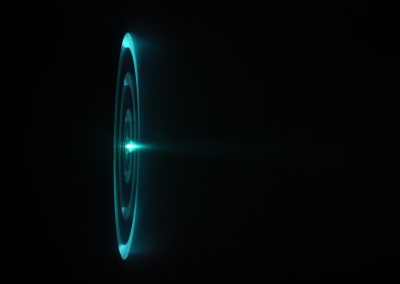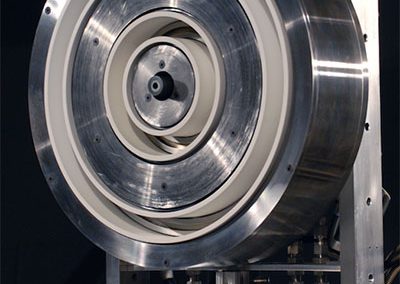Project
Nested-Channel Hall Thrusters
“Hall thrusters are an attractive EP technology to be scaled to 50 to 100-kW-class devices for [proposed] high-power missions. Modeling has suggested that specific impulses on the order of 1500-2000 seconds are optimal to reduce trip times for human crews. Ion thrusters (the only other EP technology with deep space flight heritage) typically provide efficiencies under 45% for these specific impulses but Hall thrusters are capable of total efficiencies in excess of 60% at similar conditions.”
“With these advantages in mind, NASA Glenn Research Center (GRC) undertook an effort to develop high-power Hall thrusters starting in 1999. This culminated in a series of 20-50 kW class Hall thrusters that demonstrated for the first time the performance capability of this technology at these power levels. The 50-kW class NASA-457Mv1 thruster, the highest-power thruster produced from this effort, was operated on xenon and krypton propellants through a range of operating conditions, demonstrating on xenon propellant a maximum total power of 96 kW, maximum discharge current of 112 A, maximum total efficiency of 0.58, and specific impulses from 1550-3560 seconds. This thruster demonstrated scaling techniques and physical insight for creating high-power Hall thrusters. Previous to this effort, magnetic-layer Hall thrusters were typically 1–5 kW devices. Leveraging insight from this work, NASA developed a higher-fidelity version of the thruster named the NASA-457Mv2, which demonstrated improved performance over the v1 thruster, though it was not tested beyond 50 kW discharge power. Additionally, the NASA-300M 20-kW thruster and NASA-400M 50-kW thruster were developed using similar scaling techniques, applying design lessons learned to continually improve performance. This culminated in a demonstrated peak total efficiency of 0.67 at 500 V, 20 kW with the NASA-300M on xenon propellant. A 150-kW single-channel Hall thruster was even designed using these techniques but never built. This thruster, designated the NASA-1000M, would have been 1 meter in diameter, the largest Hall thruster ever built. While the GRC program was highly successful and demonstrated a road map toward 150-kW Hall thruster systems, one of the major challenges identified in this program (and exemplified by the NASA-1000M thruster design) was the excessively large footprint of higher-power systems This is due to the fact that thruster diameter increases with power using these scaling techniques.”
“One technique to avoid this issue and scale Hall thrusters beyond 50-kW class devices while limiting diameter increase is to concentrically nest multiple discharge channels around a shared centrally-mounted cathode. This technique allows for improved packing density of the channels as compared to multiple single-channel thrusters while still relying on the proven channel scaling techniques developed by GRC. Two 10-kW class nested Hall thrusters (NHTs) have been developed, one by Busek Co., Inc. and another by the University of Michigan. The University of Michigan thruster, known as the X2, demonstrated the feasibility of multiple nested magnetic lens topologies and operation of multiple discharge channels from a single shared cathode, and generally forged a path for continued NHT development.”
“In 2009, the University of Michigan, in partnership with the Air Force Office of Scientific Research, NASA, and ElectroDynamic Applications, began development of a three-channel, 100-kW class NHT known as the X3. This thruster capitalized not only on the success of the X2 NHT but on the aforementioned series of high-power single channel Hall thrusters developed by NASA in the early 2000s. The X3 was first fired in 2013, but due to facility limitations at the University of Michigan characterization of the thruster to date has been limited to 30 kW.”
“Though NHTs have shown promise to date, there still exist questions about the performance and high-power capability of the technology. The X2, a non-optimized demonstration thruster, displayed anode efficiencies in excess of 60% during its characterization but was only throttled to 500 V discharge voltage. The 30-kW characterization of the X3 showed surprisingly low performance for the larger channels, including 23% anode efficiency on the outer channel operating alone. Previously proposed explanations for this anomalously-low performance include magnetic field and cathode coupling issues. There also remain questions regarding the mechanisms through which channels couple to one another. Early work on both the X2 and X3 showed a certain amount of cross-talk but these studies did not perform thorough investigations of the behavior. Thus, the need is apparent to continue the development of NHTs, starting with characterizing the X3 at current densities and powers closer to nominal conditions in a facility with the necessary pumping speed.”
“Despite these potential concerns, NASA considers NHTs a promising technology and is funding continued development through the Next Space Technologies for Exploration Partnerships (NextSTEP) program, which is investing in the technologies that will be necessary for future crewed missions to Mars. In total, three electric propulsion concepts are being funded by NextSTEP: the Variable Specific Impulse Magnetoplasma Rocket (VASIMR); the electrodeless Lorentz-force thruster; and the XR-100 nested Hall thruster system. The overall goal of the these projects is to demonstrate 100 continuous hours of 100-kW operation of the system operating at a total system efficiency in excess of 60%. The XR-100 system is being developed by a team led by Aerojet Rocketdyne (AR) and including the University of Michigan, NASA GRC, and the NASA Jet Propulsion Laboratory (JPL). The system consists of the X3 NHT, a JPL-developed high-current hollow cathode, and a power processing unit and xenon flow controller being developed by AR. Additional contributions include plasma and thermal modeling by JPL and facility and test infrastructure by NASA GRC.”
(This summary was quoted directly from the work of Hall et al. in “High-Power Performance of a 100-kW Class Nested Hall Thruster”, presented at the 35th International Electric Propulsion Conference in Atlanta, GA, 2017.)
Selected Publications
Far-Field Plume Measurements of a Nested-Channel Hall Thruster
Liang, R. and Gallimore, A.D.
Constant-Power Performance and Plume Properties of a Nested-Channel Hall-Effect Thruster
Liang, R. and Gallimore, A.D.
Plasma Oscillation Effects on Nested Hall Thruster Operation and Stability
M. McDonald, M. Sekerak, A. Gallimore, and R. Hofer
The Combination of Two Concentric Discharge Channels into a Nested Hall-Effect Thruster
Liang, R.
Implementation and Initial Validation of a 100-kW Class Nested-channel Hall Thruster
Hall, S., Florenz, R., Gallimore, A., Kamhawi, H., Brown, D., Polk, J., Goebel, D., Hofer, R.
An Inner Channel Simulation of the X2 Nested Channel Hall Effect Thruster
Dragnea, H.C, and Boyd, I.D.
Preliminary Results and Future Goals for a Simultaneous Characterization of a Nested-channel Hall Thruster in Experiment and Simulation
Dragnea, H.C, Boyd, I.D., Hall, S.J., and Gallimore, A.D.
The X3 100-kW Class Nested-Channel Hall Thruster: Motivation, Implementation, and Initial Performance
Florenz, R
30-kW Performance of a 100-kW Class Nested-Channel Hall Thruster
Hall, S.J., Cusson, S.E., and Gallimore, A.D
Investigation of Channel Interactions in a Nested Hall Thruster Part II: Probes and Performance
Cusson, S., Dale, E., and Gallimore, A.
Investigation of Channel Interactions in a Nested Hall Thruster Part I: Acceleration Region Velocimetry
Georgin, M.P., Dhaliwal, V., and Gallimore, A.D
Investigation of Channel Interactions in a Nested Hall Thruster
Cusson, S.E, Georgin, M.P, Dale, E.T., Dhaliwal, V., and Gallimore, A.D.
Investigation of Channel Interactions in a Nested Hall Thruster
Georgin, M.P., Cusson S.E. , Dale, E.T., Dhaliwal, V., Gallimore, A.D.
Investigation of Channel Interactions in a Nested Hall Thruster
Cusson, S.E., Dale, E.T., and Gallimore, A.D.
Expanded Thruster Mass Model Incorporating Nested Hall Thrusters
Hall, S.J., Jorns, B.A., Gallimore, A.D., and Hofer, R.R
High-Power Performance of a Nested Hall Thruster
Hall, S.J., Jorns, B.A., and Gallimore, A.D.
High-Power Performance of a 100-kW Class Nested Hall Thruster
Hall, S.J., Jorns, B.A., Gallimore, A.D., Kamhawi, H., Haag, T.W., Mackey, J.A., Gilland, J.H., Peterson, P.Y., and Baird, M.J.
Characterization of a 100-kW Class Nested-Channel Hall Thruster
Hall, Scott J.
Update on the Nested Hall Thruster Subsystem for the NextSTEP XR-100 Program
Jorns, B.A., Gallimore, A.D., Hall, S.J., Peterson, P.Y., Gilland, J.E., Goebel, D.M., Hofer, R.R., and Mikellides, I.
Development of a 30-kW Class Magnetically Shielded Nested Hall Thruster
Cusson, S.E., Hofer, R.R., Goebel, D.M., Georgin, M.P., Vazsonyi, A.R., Jorns, B.A., and Gallimore, A.D., and Boyd, I.D.
Model for the Increase in Thruster Efficiency from Cross-Channel Coupling in Nested Hall Thrusters
Su, L.L., Hall, S.J., Cusson, S.E., and Jorns, B.A.
Impact of Neutral Density on the Operation of High-Power Magnetically Shielded Hall Thrusters
Cusson, Sarah E.
Investigation of the Hall Thruster Breathing Mode
Dale, Ethan T.
The Influence of Instabilities on Electron Dynamics of a Magnetic Nozzle
Hepner, Shadrach T.
Optimization and Characterization of Facility Effects for a Low-Power Electron Cyclotron Resonance Magnetic Nozzle Thruster
Wachs, Ben N.
Ionization Instability of the Hollow Cathode Plume
Georgin, Marcel
Performance of a Rotating Magnetic Field Thruster
Woods, Joshua



